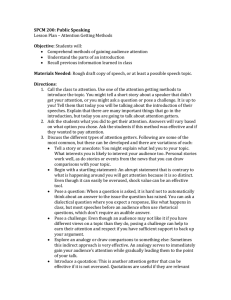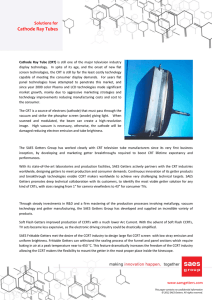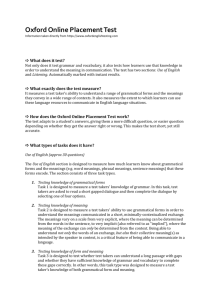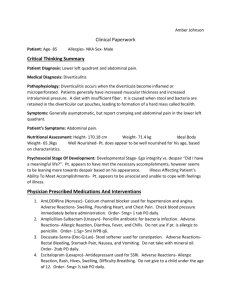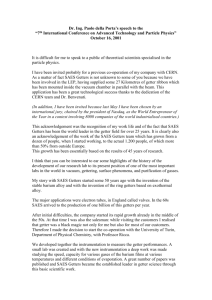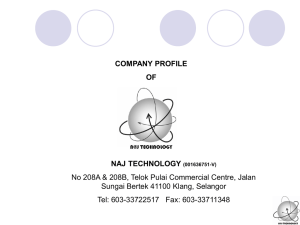Selling and Sales Management
advertisement
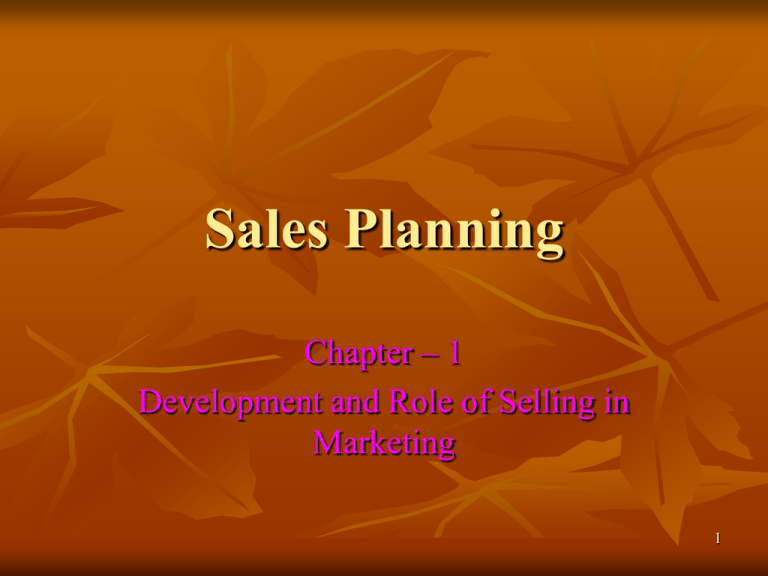
Sales Planning Chapter – 1 Development and Role of Selling in Marketing 1 The Nature and Role of Selling The simplest way to think of the nature of selling is that its function is to make a sale Characteristics of Modern Selling: Customer retention and deletion 80/20 ratio Database and knowledge management new technology internet, mobile and laptop Customer relationship management ,long relationship, win to win Marketing the products involve in marketing activities Problem solving and system selling knowledge about any problem Satisfying needs and adding value 2 Success Factors for Professional Salespeople The top ten success factors in selling: Listening skills Follow-up skills Ability to adapt sales style from situation to situation Tenacity – sticking to the task Organizational skills Verbal communication skills Proficiency in interacting with people at all levels within an organization Demonstrated ability to overcome objections Closing skills Personal planning and time management skills 3 Types of Selling Selling job varies according to the nature of the selling task. They are: Order-takers respond to already committed customers Order- creators do not directly receive orders since they talk to specifiers rather than buyers Order- getters attempt to persuade customers to place an order directly 4 Order- takers: There are three types of order takers. They are Inside order- takers – the sales person’s task is purely transactional – receiving payments and passing over the goods, telemarketing Delivery salesperson – the sales person’s task is primarily concerned with delivering the product example milk, newspaper Outside order takers visit customers , but their primary function is to respond to customer requests rather than actively persuade (replce telemarketing) 5 Order – creators are called Missionary sales people, their selling task is to educate and build good will. Examples Medical representatives call on the doctors to make them specify their medicines to the patients, similarly even in the building industry architects act as specifiers Order getters consists of those in selling jobs where a major objective is to persuade customers to make a direct purchase 6 Types of order getters are: New business sales people – whose task is to get new customers Organizational salespeople whose main job is to maintain close and long-term relationship with organizational customers. The selling job involve team selling Consumer sales people sell physical products and services to individuals example, cars, insurance and rewarded with commission 7 Technical support sales people are group of order getters who provide sales support to frontline sales people Merchandisers provide sales support in retail and wholesale selling situations example, give advice on display, check stock levels and maintain contact with store managers 8 The nature and role of sales management: The emphasis is on the word management Nowadays the sales manager is expected to play a much more strategic role in the company and is required to make a key input into the formation of the company plans. Apart from being an accountant, a planner, a personnel manager and a marketer. In order to fulfill these roles the sales managers will have to undertake the following specific duties and responsibilities 9 Determination of sales force objectives and goals Forecasting and budgeting Sales force organization Sales force size Territory design and planning Sales force selection, recruitment and training Motivating the sales force Sales force evaluation and control 10 Marketing Concept In tracing the development of the marketing concept it is customary to chart three successive stages in the evolution of modern business practice. They are Production orientation Sales orientation Marketing orientation 11 Production orientation: This era was characterized by focusing company efforts on producing goods or services. More specifically, management efforts were aimed at achieving high production efficiency, often through the large scale production of standardized items. Sales orientation: The sales oriented company is one where the focus of the company effort switches to the sales function. The main issue here is not how to produce but, having products, how to ensure that this production is sold. 12 Marketing Orientation: The marketing concept holds that the key to successful and profitable business rests with identifying the needs and wants of customers and providing products and services to satisfy them. Market segmentation and targeting are the two of the most useful concepts in marketing 13 The marketing mix in the case of goods include 4 Ps Product Price Promotion Place Product covers anything a company offers to customers to satisfy their needs. In addition to physical, tangible products offered for sale, there are also services and skills. There are a number of ways of classifying products , depending upon the basis chosen for classification. 14 The product life cycle is somewhat similar to the life cycle of humans and has four distinct stages. The stages are Introduction Growth Maturity Decline Implications of the product life cycle The first obvious implication of the concept is that even the most successful products have a finite life. A second implication of the life-cycle concept is that different marketing and sales strategies may be appropriate to each stage 15 Product adoption and diffusion: This theory was put forward by Everett Rogers in 1962 and is closely related to product life cycle. It describes innovative behavior and holds that the characteristics of a new product can affect its rate of adoption Consumers are placed into one of five adopter categories, each with different behavioral characteristics. They are Innovators, Early adopters, Early majority, Late majority and Laggards 16 Pricing As with the element of the mix, pricing decisions encompass a variety of decision areas A vital element in marketing is the buying power of customers In determination of price levels, a number of factors must be considered. The main factors include the following: Company objectives, Marketing objectives, Demand considerations, Cost considerations, Competitor considerations 17 Distribution In its broadest sense distribution is concerned with all those activities required to move goods and materials into the factory, through the factory and to the final consumer Some of the decision areas encompassed in the distribution of the marketing mix are as follows: The selection of the distribution channels Wholesalers, retailers, brokers Exclusive distribution, Intensive distribution etc., 18 Determining the level of customer service Decisions with regard to delivery periods and methods of transportation Terms and conditions of distribution Communications : Integrated Communications mix to link advertising, sales promotion, publicity and sponsorship together to convey a cohesive message to target markets, one in which each aspect supports other parts of the communications program. 19 The relationship between Sales and Marketing Perhaps the most noticeable difference between the pre- and post- marketing oriented company is the fact that sales are later seen to be a part of the activity of the marketing function Target market choice Differential advantage 20

